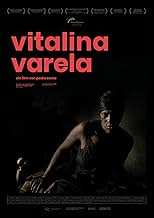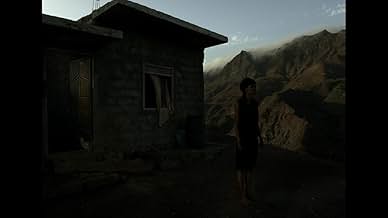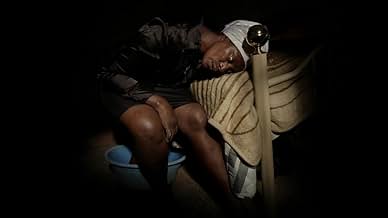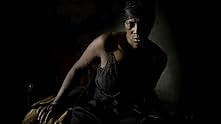Vitalina Varela
- 2019
- 2h 4min
VALUTAZIONE IMDb
6,7/10
2594
LA TUA VALUTAZIONE
Una donna capoverdiana si fa strada attraverso Lisbona, seguendo le scarse tracce fisiche lasciate dal marito defunto e scoprendo la sua vita segreta e illecita.Una donna capoverdiana si fa strada attraverso Lisbona, seguendo le scarse tracce fisiche lasciate dal marito defunto e scoprendo la sua vita segreta e illecita.Una donna capoverdiana si fa strada attraverso Lisbona, seguendo le scarse tracce fisiche lasciate dal marito defunto e scoprendo la sua vita segreta e illecita.
- Regia
- Sceneggiatura
- Star
- Premi
- 24 vittorie e 29 candidature totali
Recensioni in evidenza
A poignant story in an extraordinary setting, shown in a poetic, serene way.
Gorgeous cinematography, shot in a clair-obscur style which highlights certain distinct colours from the darkness (at times reminiscent of old masters's paintings, such as the work of Caravaggio or Rembrandt).
Strong, pure acting by the lead actors - Vitalina Varela and Ventura.
Pedro Costa tells his story slowly, but intelligently. Instead of presenting the plot outline on a silver platter, he challenges the viewer to discover this for himself. Costa's style of story-telling reminds me of Bela Tarr's films; both prefer the visual language over the spoken one.
This film is not very accessible, and requires full attention. But it will prove to be very rewarding in the end.
Gorgeous cinematography, shot in a clair-obscur style which highlights certain distinct colours from the darkness (at times reminiscent of old masters's paintings, such as the work of Caravaggio or Rembrandt).
Strong, pure acting by the lead actors - Vitalina Varela and Ventura.
Pedro Costa tells his story slowly, but intelligently. Instead of presenting the plot outline on a silver platter, he challenges the viewer to discover this for himself. Costa's style of story-telling reminds me of Bela Tarr's films; both prefer the visual language over the spoken one.
This film is not very accessible, and requires full attention. But it will prove to be very rewarding in the end.
An expressionistic melancholy spell. Painstakingly composed and beautifully lit. The texture and hues of the images are remarkable.
The images do very little of the storytelling beyond place, space, and tone. The story itself is almost completely orally told. Even then, words emerge after long ambient soundscapes of unseen "slum life" always just happening beyond the image's frames or on the other side of walls.
Whether it's day or night, it's almost always pitch, with pinpoint spotlighting illuminating only parts of this desolate world and the striking faces that occupy it. Most of the image is in consummate shadow. Until the end, when, finally, emerging from out of our mourning, we begin to see daylight and sky. Most of this sky is in memory, but not all.
The pacing is so languid and the creative choices so deliberate that we have plenty of time to live inside the images and moments.
I felt there was some Bergman here: the disenchanted priest; the memory haunted spaces and characters; the faces floating in darkness, only their eyes revealing the depths of their emotional experiences.
You are forgiven for thinking that this film is boring or could be shorter. You are forgiven for thinking that it is perfect as it is, even somehow fragile; that it creates the exact effect on the viewer that is intended.
You are forgiven for thinking and feeling anything you've ever thought and felt, as long as you turn your face towards kindness from this moment forward... but you must do it quick, before the credits roll.
The images do very little of the storytelling beyond place, space, and tone. The story itself is almost completely orally told. Even then, words emerge after long ambient soundscapes of unseen "slum life" always just happening beyond the image's frames or on the other side of walls.
Whether it's day or night, it's almost always pitch, with pinpoint spotlighting illuminating only parts of this desolate world and the striking faces that occupy it. Most of the image is in consummate shadow. Until the end, when, finally, emerging from out of our mourning, we begin to see daylight and sky. Most of this sky is in memory, but not all.
The pacing is so languid and the creative choices so deliberate that we have plenty of time to live inside the images and moments.
I felt there was some Bergman here: the disenchanted priest; the memory haunted spaces and characters; the faces floating in darkness, only their eyes revealing the depths of their emotional experiences.
You are forgiven for thinking that this film is boring or could be shorter. You are forgiven for thinking that it is perfect as it is, even somehow fragile; that it creates the exact effect on the viewer that is intended.
You are forgiven for thinking and feeling anything you've ever thought and felt, as long as you turn your face towards kindness from this moment forward... but you must do it quick, before the credits roll.
In this movie Vitalina Varela performs her own person role in an event of her personal life as a non-professional actress.
As a Capeverdian living in Cape Verde (a former Portuguese colony) she saw her husband leaving to work in Lisbon, Portugal. Only 25 years later she managed herself to leave to Portugal to join her husband. However she arrived there three days after his death. Then an atmosphere of sorrow and bitterness sets itself in the movie even suggested by the image darkness, the slow movement of characters and their foreground plan faces. Meanwhile Vitalina becomes aware that her husband's behaviour was rather illicit.
A remarkable movie direction by Pedro Costa.
As a Capeverdian living in Cape Verde (a former Portuguese colony) she saw her husband leaving to work in Lisbon, Portugal. Only 25 years later she managed herself to leave to Portugal to join her husband. However she arrived there three days after his death. Then an atmosphere of sorrow and bitterness sets itself in the movie even suggested by the image darkness, the slow movement of characters and their foreground plan faces. Meanwhile Vitalina becomes aware that her husband's behaviour was rather illicit.
A remarkable movie direction by Pedro Costa.
For over two hours in what might as well be catacombs, we watch humans
walk like zombies in slow motion, or staring into space unmoving, hardly saying a word, except for whispered voice overs so as not to disturb the dark.
After a 20-year separation a woman arrives to join her husband but he was
buried three days before. That's about the extent of the story. About the only action is watching people smoke for lack of anything to do.
Everyone's miserable and pining for the good old days. The priest when he used to have a full house (though he can still pay for the funeral and everyone's bills). The woman when she was young and active. We don't know who the other characters are. Finally, we get to see the light of day. But turns out it's a
flashback to when the young couple built their house.
So the only hope is to live in the past, as there is no present or future?
The islands of Cabo Verde (Cape Verde), in the Atlantic, 600 km west of the Senegal coast were a Portuguese colony until 1975. As a country, they enjoy the dubious distinction of having more of its citizens living abroad (700,000) than at home (560,000), which reflects the lack of job opportunities. In particular, about 100,000 live in Portugal, most of them eking out a living out of low paying jobs.
The scenario is Cova da Moura, a suburb of Lisbon, whose inhabitants are 75% from Cape Verde. Its houses were constructed by the locals, without the benefit of a permit. It is an urban island without open spaces, with streets of random widths and serious crime problems,
The main character is Vitalina Varela (played by herself), Her husband Joaquim left her (and his homeland) 25 years ago in search of better opportunities. He settled in Cova da Moura, where he built a precarious house, with insufficient light, crumbling walls, leaking roof and untiled floor (he and Vitalina had constructed a cheerful, airy house back home). Vitalina hears no more of him until she is informed that Joaquim has taken ill. She flies to Lisbon but arrives three days after the funeral. She learns about Joaquim's life from various dwellers of the shantytown. She also reconnects with a priest that she knew from the islands.
This is it. Director Pedro Costa tells the tale in a rather peculiar way. The pace is slow, sometimes excruciatingly so. Every shot by cinematographer Leonardo Simões is carefully composed; the lighting is unabashedly artificial and produces chiaroscuro scenes that, of course, remind one of Caravaggio. Crumbling cement walls, squalid interiors and unpaved lanes take a three dimensional quality and a life of their own. We don't see the shantytown as the locals see it but through the eye of a painter. We all "know" that excessively elaborate cinematography may interfere with the tale being told, but the director stands this rule on end. The final result is worth watching, even if only for the visuals.
The scenario is Cova da Moura, a suburb of Lisbon, whose inhabitants are 75% from Cape Verde. Its houses were constructed by the locals, without the benefit of a permit. It is an urban island without open spaces, with streets of random widths and serious crime problems,
The main character is Vitalina Varela (played by herself), Her husband Joaquim left her (and his homeland) 25 years ago in search of better opportunities. He settled in Cova da Moura, where he built a precarious house, with insufficient light, crumbling walls, leaking roof and untiled floor (he and Vitalina had constructed a cheerful, airy house back home). Vitalina hears no more of him until she is informed that Joaquim has taken ill. She flies to Lisbon but arrives three days after the funeral. She learns about Joaquim's life from various dwellers of the shantytown. She also reconnects with a priest that she knew from the islands.
This is it. Director Pedro Costa tells the tale in a rather peculiar way. The pace is slow, sometimes excruciatingly so. Every shot by cinematographer Leonardo Simões is carefully composed; the lighting is unabashedly artificial and produces chiaroscuro scenes that, of course, remind one of Caravaggio. Crumbling cement walls, squalid interiors and unpaved lanes take a three dimensional quality and a life of their own. We don't see the shantytown as the locals see it but through the eye of a painter. We all "know" that excessively elaborate cinematography may interfere with the tale being told, but the director stands this rule on end. The final result is worth watching, even if only for the visuals.
Lo sapevi?
- QuizOfficial submission of Portugal for the 'Best International Feature Film' category of the 93rd Academy Awards in 2021.
- ConnessioniSpin-off from Cavallo Denaro (2014)
I più visti
Accedi per valutare e creare un elenco di titoli salvati per ottenere consigli personalizzati
- How long is Vitalina Varela?Powered by Alexa
Dettagli
Botteghino
- Lordo Stati Uniti e Canada
- 14.941 USD
- Fine settimana di apertura Stati Uniti e Canada
- 4612 USD
- 23 feb 2020
- Lordo in tutto il mondo
- 56.860 USD
- Tempo di esecuzione
- 2h 4min(124 min)
- Colore
- Proporzioni
- 1.33 : 1
Contribuisci a questa pagina
Suggerisci una modifica o aggiungi i contenuti mancanti




















